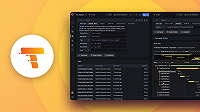Using cross-tenant and cross-cluster query federation
Grafana Enterprise Traces (GET) can perform cross-tenant and cross-cluster query federation using the optional federation-frontend service. This service aggregates the data from multiple GET clusters and from multiple tenants in a single trace lookup or search query. It works by reverse proxying the read path of GET clusters and merging the results into a single response.
The federation-frontend target itself requires a configured GET installation installed using the tempo-distributed Helm chart. No other GET components are required.
You can run the federation-frontend service on its own.
Cross-tenant query federation
GET supports creating access policies that can span multiple tenants. Viewers in Grafana Enterprise can see data coming from more than one tenant simultaneously.
To read more about tenant federation, see the Cross-tenant query federation page.
Cross-cluster query federation
Cross-cluster query federation allows a team that is globally responsible for all observability to make a single query across the GET clusters for all regions to retrieve trace results.
To read more about cluster federation, see the Cross-cluster query federation page.
Limitations of the federation-frontend
This feature has one known limitation:
- No result caching in the federation-frontend
If your use-case is blocked by a limitation, please reach out through our support channels with a feature request.
Was this page helpful?
Related resources from Grafana Labs



